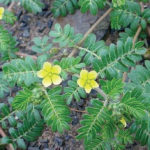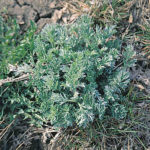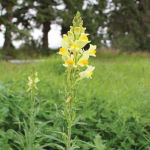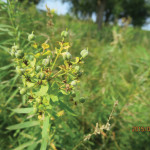Reading Time: < 1 minute A new season of Working Well workshops gets underway this month. Since it was launched in 2008, there have been 254 workshops on how to properly care for water wells and protect groundwater resources. More than 6,900 people in 172 different communities have taken the workshops, which are put on by several provincial departments and […] Read more

Popular Working Well program launches new season

Crop Protection ‘Blue Book’ goes mobile
Reading Time: < 1 minute The Blue Book has long been popular reading in the homes of Alberta farmers — and now they can read it anywhere on their smartphones. The Crop Protection book (as it is officially known) is updated annually for previously registered products and includes newly registered pesticide products — herbicides, pesticides, seed treatments, and foliar fungicides. […] Read more

Devil’s trumpet is a potentially deadly invader
Noxious Weeds: Jimsonweed
Reading Time: < 1 minute Although its exact origin is unknown, devil’s trumpet — otherwise known as jimsonweed — is found in many countries around the world in both agricultural and ornamental settings. Introduced to this province as a contaminant of agricultural seed, this smelly weed is under review by the provincial Agriculture Ministry and it has been recommended to […] Read more

A weed that prospers on degraded pasture
Noxious Weeds: Hoary alyssum
Reading Time: 2 minutes Thought to be brought to North America as a seed contaminant from Europe, hoary alyssum is toxic to horses and other livestock. It has a variety of life cycles depending on site and weather conditions, which makes this weed tricky to control. A prohibited noxious weed in Alberta, this pest can be easily identified. Hoary […] Read more

Keep watch for this potential new invader
Noxious Weeds: Puncturevine
Reading Time: < 1 minute So far uncommon to Alberta, puncturevine has all the makings of a potential headache to you and me, alike. What started as an annual herb in southern Europe has started spreading into Canada (in British Columbia and Ontario). Like most other weeds, this plant prefers areas of disturbed, bare ground and grows as a summer […] Read more

This quick-spreading weed gets an early start
Noxious weeds: Canada thistle
Reading Time: < 1 minute Spring brings lovely native flowers, but also noxious weeds. The aggressive perennial Canada thistle is a favourite of disturbed soils of all types. It starts sending shoots from horizontal roots to the surface of soil around mid-April, with flowers to follow in mid-June and continuing throughout the summer. Easy to distinguish from other weeds, this […] Read more

Don’t be fooled by this weed’s pretty flower
Noxious weeds: Field scabious
Reading Time: < 1 minute Field scabious was introduced as an ornamental from Europe and is now taking over roadsides and pastures. It can be found throughout central Alberta and has the ability to invade even undisturbed plant communities, such as hayfields. Once established it is very difficult to control. Flowers can be a purple- to blue-coloured clustered head, resembling […] Read more

You won’t raise a glass to this invasive weed
Noxious Weeds: Absinthe wormwood
Reading Time: < 1 minute A tough, semi-woody perennial plant native to Europe and Asia, absinthe wormwood typically grows in stems and forms in a clumping habit. The most distinguishing feature of the plant is its finely divided leaves combined with a silvery-grey colour. Absinthe wormwood also has a very strong and distinct odour which is very similar to sage. […] Read more

Don’t be fooled by yellow toadflax’s good looks
Reading Time: < 1 minute It’s often mistaken for a type of snapdragon, but don’t be fooled by this invader of fields and pastures. Originally brought from Europe as an ornamental, quick-spreading yellow toadflax — a.k.a. wild snapdragon — is found all across North America. It spreads by both seed (up to 5,000 seeds per stem) and its creeping root […] Read more

Don’t let this invader take hold
Reading Time: < 1 minute Leafy spurge is common throughout Alberta due to its ability to adapt to a variety of soil types through its extensive creeping root system. Stems are smooth and arranged in clumps, can grow up to a metre tall, and contain a milky latex. When it comes into contact with skin, the latex can cause irritation […] Read more

